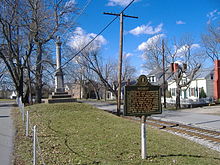Midway Historic District (Midway, Kentucky)
Midway Historic District is a listed area in Midway , Kentucky that was listed as a Historic District on the National Register of Historic Places on November 17, 1978 . With the Midway center in decline, a major street design renovation was undertaken in 2003 as part of the Kentucky Main Street Program .
Midway was the first town to be built in Kentucky by a railroad company. The Lexington and Ohio Railroad (L&O) pursued the goal of connecting Lexington with the Ohio River and bypassing Louisville . The railway company built a line between Frankfort, Kentucky and Lexington from 1831 . The first train reached the midpoint of the segment ( engl. Midway ) of 1833, on the grounds of a farm that belonged to a John Francisco. On January 31, 1835, the railroad bought the Francisco Farm for $ 6,491.25 (today's prices: $ 194,000) and had the town planned by its civil engineer, RC Hewitt. The place was named Midway because it was about halfway between Frankfort and Lexington. Many of the city's streets were named after people who worked for L&O.
Description of the district
The Midway Historic District includes portions of Winter, Main, Railroad, Wassau, Bruen, Cross, Higgins, Stephens, Parrish, Walnut, Johnson, Dudley, Turner, Starks, Church, Gratz, Smith and Brand Street as well as US Highway 62 , the Parrish Hill Farm and Midway College, however, most of the contributing properties are on Winter, Railroad and Main Streets. At the time of nomination to the National Register in April 1978, there were 242 buildings in the historic district, of which 66 were not considered contributing due to insufficient age or major changes.
The significance of the Midway Historic District is due to its composition, as the houses have retained their 19th and early 20th century character. Most of the buildings were constructed in the 1840s to 1870s, and to a lesser extent in the 1890s. The streetscape has changed little since then.
Although the railway is now equipped with more modern technology, the route through the city is still used on its original route. It divides the business district in two along Railroad Street.
According to local tradition, the porterhouse steak is said to have been invented in Midway, in the still existing Porter House, but there are a number of other theories about the origin of the term.
A museum shop is now located in the two-story Italianate-style building at 124 E. Railroad Street , believed to have been built as a saloon by Henry Baxter Russell from around 1880 to 1882. It was bought in 1915 by the Sons and Daughters of Relief , an African-American association , who then operated a bar and restaurant and used the second floor as a meeting room.
The Second Christian Church is believed to be the oldest black community in Kentucky.
See also
supporting documents
- ↑ Entry in the National Register Information System . National Park Service , accessed June 12, 2016
- ^ Kleber, John E. Kentucky Encyclopedia . (University Press of Kentucky, 1994). P. 551.
- ↑ Kentucky Historical marker 1580
- ↑ a b Historic Midway, Kentucky ( Memento of the original from December 26, 2007 in the Internet Archive ) Info: The archive link was automatically inserted and has not yet been checked. Please check the original and archive link according to the instructions and then remove this notice.
- ↑ a b Jean Rouse (Midway Woman's Club) and Daniel Kidd (Kentucky Heritage Commission): Midway Historic District nomination form ( English , PDF; 2.3 MB) In: National Register of Historic Places . National Park Service . April 1978. Retrieved July 15, 2010.
- ↑ Historic Midway Museum Store (English)
- ↑ Savage, Beth. African American Historic Places , p. 253

